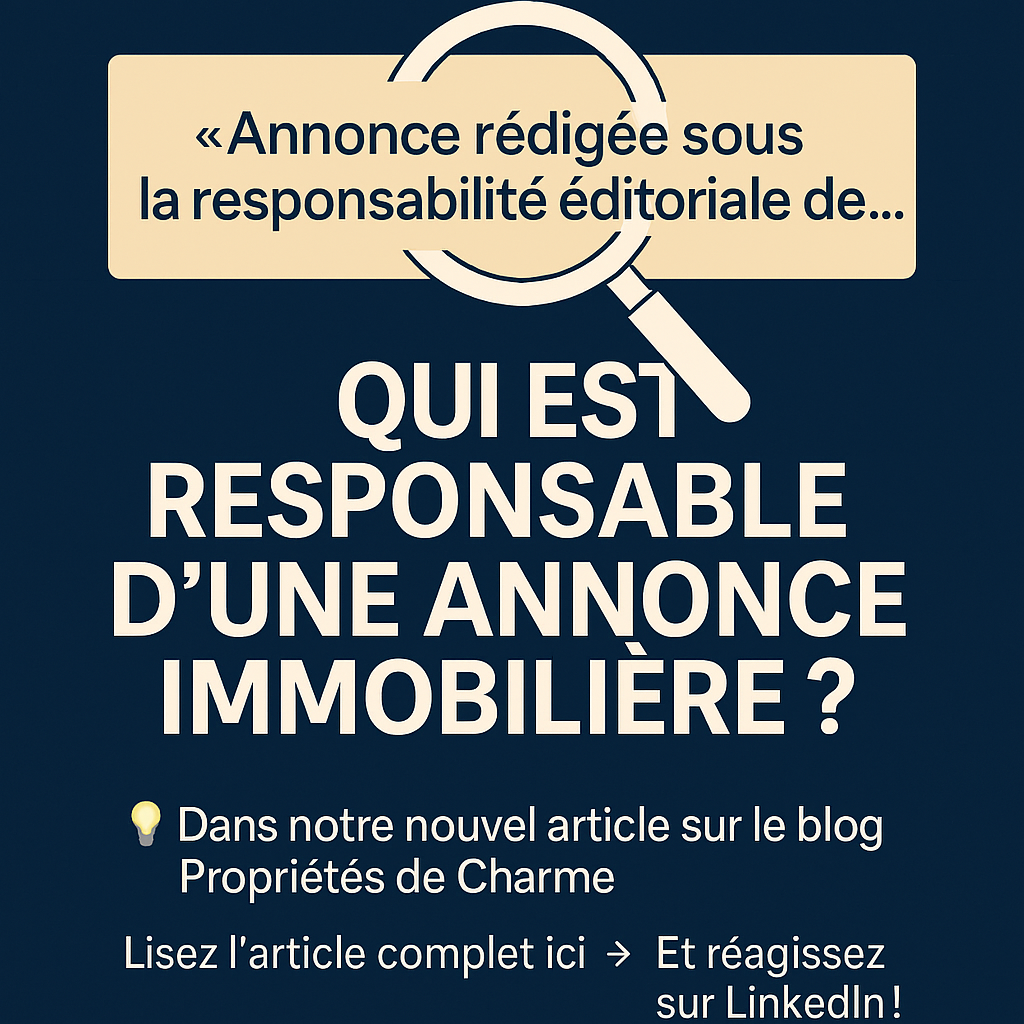Legal notices in real estate advertisements from agents:
decryption and issues
When you look at real estate listings online, especially those published by brokerage networks, one recurring mention catches the eye:
“This real estate advertisement was written under the editorial responsibility of Mr. or Mrs. X, independent real estate agent (without holding funds), commercial agent of the Y network, registered with the RSAC of Z under number XX, holder of the real estate canvassing card on behalf of company Y.”
This type of text raises questions for sellers, buyers and even professionals: why do such details appear in the description of the property , when it should be devoted solely to promoting the property (surface area, services, location, photos, etc.)?
This article aims to decipher these mentions, explain their origin, their usefulness (or their uselessness), and analyze their impact on customer perception.
🏡 Mandatory information and legal responsibilities in real estate advertisements by network agents
🎯 Legal notices for agent advertisements: lighting
Why do agent advertisements contain these legal notices? Analysis of the legal framework and responsibilities in real estate.
Introduction: a phenomenon that challenges
For several years, anyone who consults real estate advertisements on the Internet has noticed a recurring peculiarity when it comes to advertisements published by networks of agents: the famous mention "Advertisement written under the editorial responsibility of..." , followed by the name of the independent advisor. This formula, absent from advertisements published by traditional real estate agencies, has become a standard in the world of networks.
This observation immediately raises several questions. Why do these mentions appear almost systematically? Is it a legal obligation imposed by French regulations, or is it a precaution taken by the networks to protect themselves? What role does the independent real estate agent actually play in the editorial responsibility chain, and how is this practice perceived by sellers and buyers?
The question is not trivial. A real estate listing must, above all, showcase a property and convey clear information to the prospective buyer. The addition of legal notices, sometimes perceived as cumbersome or superfluous, can blur the initial message. On the one hand, some see it as a guarantee of transparency and seriousness. On the other, many believe that these notices add no added value to the listing itself and raise questions about the reality of liability.
The objective of this article is therefore threefold: to analyze the legal framework governing the distribution of real estate advertisements in France, to explain why and how these notices were put in place by the networks of agents, and finally to explore their practical and psychological impact, both for professionals and for individuals.
2. Real estate advertisements: legal framework in France
The distribution of real estate advertisements in France is not simply a matter of marketing: it is strictly regulated by law. The goal is twofold: to protect the consumer (buyer or tenant) by ensuring clear, fair, and non-misleading information, and to hold the professionals who distribute these advertisements accountable.
2.1. Reference texts
Several texts structure this legal framework:
The Hoguet Law (1970) and its implementing decree (1972), which set out the conditions for practicing the real estate profession. Only a professional card holder may legally exercise a real estate transaction or management activity.
The Consumer Code , which prohibits any misleading commercial practice and requires clear and precise information.
The ALUR law (2014) , which reinforced the obligations to display fees and legal information in advertisements.
Therefore, any advertisement must indicate mandatory elements: sale price, nature of fees, energy performance diagnosis (DPE), living area (for certain properties), and, in the context of rental, the amount of the security deposit and charges.
2.2. The question of editorial responsibility
An essential point is often misunderstood: the advertisement is never the personal responsibility of the negotiator or agent , but rather that of the holder of the professional card . In fact, the commercial agent (whether he works for a traditional agency or for a network of agents) acts solely in the name and on behalf of the card holder.
In other words, in the event of a false, incomplete, or misleading advertisement, it is the holder of the professional card who will be held accountable, not the agent himself. The latter certainly remains responsible for his actions vis-à-vis the network or agency (commercial contract), but legally, vis-à-vis the client and the authorities (DGCCRF, for example), the final responsibility rests with the cardholder.
2.3. Obligations of agents and commercial representatives
Independent real estate agents must be registered with the RSAC (Special Register of Commercial Agents) and hold a certificate of collaboration issued by the CCI in the name of the network that mandates them. They may not hold funds or draw up any binding legal documents (such as a sales agreement). Their role is limited to prospecting, presenting properties and offers, and supporting clients.
2.4. The practice of mentioning “under the editorial responsibility of…”
So why do we see this mention in network advertisements? Legally, there is no requirement that the agent appear as "editorial manager." This practice is more a matter of transparency or internal communication strategy within the networks , intended to highlight the advisor's name as the contact identified by the customer. But in reality, it maintains an ambiguity by suggesting that responsibility for the advertisement lies with the sales agent, when the law clearly designates the cardholder.
3. Why do these mentions appear mainly in networks of agents?
The words "Advertisement written under the editorial responsibility of..." appear almost systematically in advertisements published by real estate agent networks. However, it is rare, if not absent, in advertisements published by traditional agencies. This difference raises the question: why such a gap in practices?
3.1. The structure of the networks of agents
Agent networks operate differently from traditional agencies. They are based on a decentralized model:
The network headquarters holds the professional card and ensures the legal framework.
Independent agents , registered with the RSAC, carry out their commercial activity as commercial agents, without being employees or partners of the company holding the card.
These independents are scattered throughout the country, often without physical offices. To give each one visibility and reassure customers, the networks have adopted the practice of clearly indicating the name of the agent associated with the advertisement. The mention "editorial responsibility" is then used as a personalization and identification tool.
3.2. A logic of communication rather than legal
In practice, this statement does not change the legal framework: the legal responsibility for the advertisement remains with the holder of the professional card . But from a marketing point of view, the networks want:
Promote their agents by giving them individual visibility, almost as if they were “their own agency”.
Create a direct link between the client and the advisor, by establishing a close relationship.
Stand out from traditional agencies , often perceived as impersonal, by highlighting the face and name of the local advisor.
In other words, it is a choice of internal communication within the networks, and not a legal obligation.
3.3. A source of confusion for customers
This practice is not without consequences. For an uninformed customer, the mention "under the editorial responsibility of..." can be misleading:
It suggests that the agent is legally responsible for the advertisement, when he does not have this legal power.
It can create a false impression of autonomy, as if each advisor were independent of their network, which is not the case.
It can complicate recourse in the event of a dispute: a dissatisfied buyer or seller might believe that they must turn to the agent, when only the company holding the card can be held responsible.
3.4. Almost exclusive use of networks
If traditional agencies don't use this term, it's because they don't feel the need to. In a traditional agency, advertisements are published under the agency's identity (which holds the professional card). Employed negotiators or sales agents appear as interlocutors, but without being presented as "editorial managers."
The contrast therefore comes from the strategy of the networks of agents, who seek to balance two contradictory imperatives:
Legal centralization (the professional card is unique, at the headquarters).
Commercial autonomy displayed (each agent is put forward as their own local representative).
3.5. A contested practice?
Some legal experts and professionals believe that this statement creates harmful ambiguity because it blurs the distinction between legal liability and commercial communication. While it is not illegal in itself, it could be considered confusing under consumer law, which requires fair and transparent information.
4. The practical and legal issues of the mention
The appearance of the phrase "Advertisement written under the editorial responsibility of..." is not neutral. It raises several issues that affect the clarity of the information given to consumers , the legal responsibility of professionals and the credibility of the real estate sector .
4.1. For customers: transparency or confusion?
From the perspective of buyers or sellers, the mention can be perceived in two ways:
As a guarantee of clarity : the name of the agent is visible, the client knows who he is speaking to and can easily identify his contact.
As a source of confusion : Most individuals are unaware of the distinction between a real estate agent holding a professional license and a commercial agent. Many believe that the agent is the agency itself and that they assume direct legal responsibility, which is false.
In the event of a dispute, this ambiguity can become problematic: a customer could turn to the agent when only the company holding the card is legally responsible for the advertisements published.
4.2. For agents: increased visibility but unclear responsibility
This mention has advantages for agents:
It highlights their name and professional identity , strengthening their local reputation.
It gives them the image of an independent professional, autonomous in their communication.
But it also has disadvantages:
It may lead one to believe that they are taking on editorial or legal responsibility that they do not have by right. In reality, an agent is only an intermediary, a commercial representative of the cardholder.
It can expose agents to direct criticism from dissatisfied clients, even though they are not the legal decision-makers.
4.3. For networks: a marketing tool but a risk of ambiguity
For networks of agents, the objective of this practice is clear: to give a strong identity to each advisor while maintaining the centralized legal structure. This allows:
Retaining agents , who feel valued.
Reassure customers by displaying a human and personalized contact.
Multiply the visibility of the network , because each agent becomes a potential entry point.
But this strategy has a downside:
It can be perceived as misleading , as it suggests a transfer of responsibility that does not legally exist.
It could, in the long term, attract the attention of regulators (DGCCRF, CNIL, etc.) if the wording is deemed likely to mislead consumers.
4.4. The legal framework recalled
Hoguet Law and its implementing decree clearly define who is responsible:
Only the holder of the professional card can carry out real estate transactions and incur liability.
Independent agents are registered as commercial agents with the RSAC and do not have an independent legal existence in the contractual relationship with clients.
Therefore, even if the mention highlights the name of an agent, it is always the card holder who remains legally responsible for the content of the advertisements .
4.5. A question of image for the entire sector
Beyond the strictly legal aspect, the use of this term raises a question of credibility. The real estate market already sometimes suffers from a blurred image, with the coexistence of traditional agencies, networks of agents, and hybrid players. Adding ambiguous wording can accentuate the feeling of opacity for the general public.
Some professionals are therefore calling for clarification of practices :
Either by removing this mention deemed misleading.
Either by replacing it with a more transparent formula, recalling that the agent is a commercial intermediary for the network that holds the card.
5. Perceptions and criticisms in the profession
The mention "Advertisement written under the editorial responsibility of..." does not leave the real estate world indifferent. Between traditional agencies , networks of agents , lawyers and clients , the reactions are mixed.
5.1. Traditional agencies: palpable annoyance
Traditional real estate agencies, holders of the professional card, often see this mention as a form of unfair competition .
They point out that they are the ones who actually assume legal responsibility for the advertisements, with all the regulatory obligations that result from this (financial guarantee, professional liability insurance, record keeping, etc.).
For them, highlighting the name of an agent as if they had an independent editorial role amounts to blurring the rules . This confuses the client's perception, who may believe that an agent is equivalent to a real estate agent.
Many agencies therefore consider that this formulation contributes to a downward levelling of the profession , by maintaining confusion between legal status and operational role.
5.2. Agent networks: a promotion tool
Conversely, large networks of agents defend this practice.
For them, displaying the advisor's name is a way to personalize the customer relationship . Rather than an abstract entity, the buyer or seller has an identified contact .
This mention also becomes a powerful marketing tool : each agent builds a personal image, while remaining under the legal umbrella of the network.
Finally, they believe that this builds loyalty among the agents , who feel recognized as real actors and not just executors.
According to their argument, it is not about misleading the consumer, but about clearly showing who wrote the advertisement, without calling into question the legal responsibility of the network.
5.3. The representatives: between pride and worry
On the part of the representatives themselves, the perception is ambivalent.
Positive : Their name appears systematically, which increases their local visibility and personal notoriety . This also facilitates the development of a client portfolio.
Negative : Some people fear being seen as directly responsible , especially in the event of a dispute or error in an advertisement. However, legally, they have neither the card nor the authority to sign on behalf of the network.
Some experienced agents see it as a double-edged sword : a powerful communication tool, but one that also exposes them to expectations and criticism that they cannot always meet.
5.4. Lawyers and regulators: increased vigilance
Lawyers specializing in real estate law and consumer law point to a legal risk .
This statement can be analyzed as misleading , because it suggests that the agent assumes independent editorial responsibility.
However, the Hoguet law and case law are clear: only the card holder is responsible.
The DGCCRF could, in the long term, take an interest in this practice if it believes that it misleads consumers . Some professionals even fear mandatory legal clarification , which would put an end to this type of formulation.
5.5. The impact on the image of the profession
Ultimately, this mention crystallizes a broader debate:
Should we modernize real estate communication by putting advisors more at the forefront, as the networks want?
Or should we, on the contrary, preserve clarity and legal rigor , as traditional agencies demand?
This divergence reveals a fundamental tension in French real estate: on the one hand, the search for flexibility and personalization ; on the other, the demand for security and transparency .
Many fear that the proliferation of ambiguous terms will undermine the image of the profession in the eyes of the general public, who demand simplicity and trust above all.
6. Development prospects and recommendations
The statement "Advertisement written under the editorial responsibility of..." raises many questions. It highlights a gap between the legal reality , established by the Hoguet law, and the commercial practices of the networks of agents. The future of this wording could involve clarifications, both from the professional players and the authorities.
6.1. A necessary legal clarification
To date, the Hoguet law clearly establishes that responsibility for advertisements lies with the holder of the professional card . However, the current wording suggests that the agent is himself responsible for drafting and distributing the advertisement.
A legislative or regulatory development could explicitly prohibit this type of ambiguous wording.
Failing this, an official reminder from the DGCCRF or the National Council for Real Estate Transactions and Management (CNTGI) could clarify the rules for presenting legal notices on advertisements.
One option would be to impose a standardized mention, for example:
“Advertisement published on behalf of [Name of professional card holder], written by [Name of agent], independent commercial agent.”
This would make it possible to clearly distinguish the legal responsibility from the editorial role.
6.2. Networks of agents: towards greater transparency
To remain credible and avoid any legal risk, networks would be well advised to adopt an internal communications charter .
This charter could set a framework for how announcements should be signed and presented.
By giving more visibility to the consumer, the networks would gain in confidence and legitimacy .
They could also support their agents with legal and marketing training to make them aware of the limits of their status.
In practice, it is not a question of restricting the visibility of agents, but of avoiding confusion between commercial role and legal responsibility.
6.3. Traditional agencies: an educational opportunity
Traditional agencies can turn this situation into an advantage.
They have a clear advantage: their legally recognized status and their direct responsibility .
By promoting this security to sellers and buyers (“Your ad is guaranteed by an agency holding the professional card”), they can differentiate themselves from the networks.
They can also use this controversy to reinforce their image of professionalism and seriousness .
In other words, rather than just denouncing the practice, traditional agencies could use it as a positive marketing argument .
6.4. For customers: a requirement for clarity
For consumers, the challenge is simple: knowing who to contact in the event of a problem .
If an ad contains an error, who is responsible: the agent or the network?
If a buyer feels cheated, who should they sue: the advisor or the cardholder?
Greater transparency on these points would strengthen confidence in the real estate market , which is already sometimes criticized for its opacity.
6.5. Towards peaceful cohabitation?
In the long term, it is likely that this statement will evolve towards a more balanced formulation , allowing both:
to promote the work of the agent (field worker, close to the client),
to remind the legal responsibility of the agency or network (guarantor of compliance with the law).
This cohabitation, if well managed, could lead to clearer communication, beneficial for the entire profession.
🔎 Summary: the mention “under the editorial responsibility of” in the advertisements of the networks of agents
For several years now, a particular formulation has regularly appeared in advertisements published by networks of agents:
👉 “Advertisement written under the editorial responsibility of…”
While it may seem innocuous, this statement actually raises legal and perception issues. The Hoguet Law stipulates that legal responsibility for an advertisement lies with the professional card holder, not the agent, who remains an independent commercial agent. However, this formula suggests that the agent assumes editorial responsibility that they do not legally hold.
🎯 Why this practice?
It pursues two main objectives:
Promote the role of the agent with the client
Create an image of proximity and personalization
⚖️ The issues:
Legal: ensuring liability in accordance with the law
Operational: supervising network communication practices
Marketing: Differentiating yourself from traditional agencies
🔄 What's next?
Clarification is needed. Whether it involves regulatory changes or an internal network charter, the goal remains the same: ➡️ to ensure transparency, protect sellers and buyers, and strengthen confidence in the real estate profession.
Also read:
3-4% Commission: A Trap for Luxury Real Estate
Real estate agents and representatives: legal responsibilities
Ramatuelle - Charming Provencal property
- 7 500 000 €
- 250 m²
- 5360 m²
- Pieces: 5
- Beds: 5
EXCEPTIONAL – ROOF VILLA – TERRACE 303 M²
- 1 895 000 €
- 121 m²
- Pieces: 4
- Beds: 3
Beautiful villa with sea view
- 3 200 000 €
- 130 m²
- 573 m²
- Pieces: 4
- Beds: 3
Beautiful Property On 2 Levels 1 Hour From Paris, Bû 28410
- 715 000 €
- Piece: 0
- Bed: 0
Nice - Gairaut - Villa in private domain
- 995 000 €
- 140.16 m²
- Pieces: 7
- Beds: 4
For sale - new house 220 m² swimming pool, jura view - prevessin
- 1 340 000 €
- 220 m²
- 3700 m²
- Pieces: 7
- Beds: 4
We can remind you quickly and give you all the information you need. A sales advisor will contact you.








